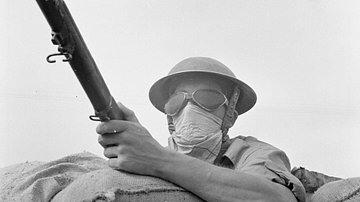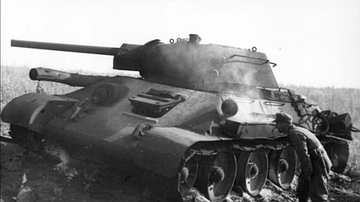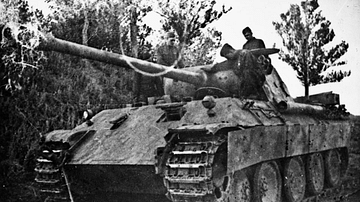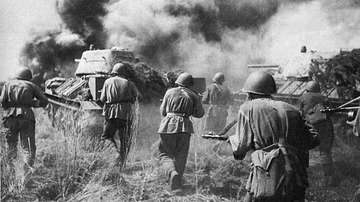The Battle of Kursk (Jul-Aug 1943), which involved nearly 6,000 tanks, was the largest tank battle in history and ended in a decisive victory for the Red Army in WWII (1939-45). Two Axis armies had attempted to cut off a Red Army bulge in the Eastern Front but were defeated due to the Soviets possessing pre-battle intelligence, excellent ground defences, and superior numbers. The Soviet victory at Kursk, which includes for some historians the taking of Orel (Oryol) and Kharkov (Kharkiv) immediately after, was "the decisive turning-point of the German-Soviet war, the point after which the Soviet forces permanently held the initiative" (Dear, 516).
The German-Soviet War
Adolf Hitler (1889-1945), the leader of Nazi Germany, had launched Operation Barbarossa, the code name for the attack on the USSR, on 22 June 1941. Early victories such as the Battle of Kiev in 1941 led to great territorial gains and the capture of some 2 million Red Army soldiers, but still the Soviet Union fought on. Joseph Stalin (1878-1953), the Soviet leader, reacted to the initial defeats and brutal nature of the campaign by declaring this a 'Patriotic War' where everyone must offer nothing less to the enemy than a 'relentless struggle'. The Red Army won its first victory at the Battle of Moscow in January 1942, successfully held out in the siege of Leningrad (Saint Petersburg), and destroyed Hitler's Sixth Army at the Battle of Stalingrad (Volgograd) in February 1943. As the Axis invaders were pushed back westwards, the Red Army struck again in the summer of 1943, this time in the largest tank engagement in history.
The Opposing Armies
The city of Kursk, located near the border of Russia with Ukraine, was a major railway and road hub. The Eastern Front around Kursk had formed a bulge, which the Axis armies were keen to exploit. Hitler wanted a major battlefield victory that would restore morale after the defeat at Stalingrad. The Kursk bulge or salient was 118 miles (190 km) across and 75 miles (120 km) deep and had been created to help the Red Army launch its next offensive. The Axis armies formed two main groups, one to the north and another to the south of Kursk, led by Field Marshal Günther von Kluge (1882-1944) and Field Marshal Erich von Manstein (1887-1973), respectively. Hitler ordered Operation Citadel (Zitadelle) to be launched on 4 May, the objective being to close off the Kursk bulge. Then the Nazi leader changed his mind and postponed Citadel, first until mid-June and then to 5 July. These delays were made in order to build up a concentration of Axis forces in the area and to send reinforcements (which, in the event, did not arrive in the quantities the commanders in the field had requested). Another reason for the delay was that several senior commanders doubted the chances of the operation's success. The delay was significant. Aware of the threat posed by the two enemy army groups, the Soviets strongly reinforced their own positions to the north and south of Kursk from as early as May.
The two Soviet fronts within the Kursk salient were the Central Front (north) and the Voronezh Front (south), which were commanded by Marshal Konstantin Rokossovsky (1896-1968) and General Nikolai Vatutin (1901-1944), respectively. In addition, to the north of the salient were the West and Bryansk Fronts, while to the far south was the Southwest Front. All of these fronts would close and engage with the enemy as the battle progressed.
The Red Army had used the delay to prepare a large number of trench defences around the Kursk salient, a task greatly helped by 300,000 local civilians. Minefields were also laid; in some areas, each mile (1.6 km) of front had 2,500 anti-personnel mines and 2,200 anti-tank mines. The minefields were often set in such a way that they channelled the attackers to areas with a high concentration of artillery. In total, 943,000 mines were laid around the salient. A mine could blow the track off a tank, which would require the crew to change the damaged section, a task that could take an hour in favourable circumstances, assuming more serious damage had not been inflicted on the tank's wheels. The number and depth of the minefields at Kursk was a significant factor in the battle's outcome.
Another Red Army strength was its artillery. The largest Soviet artillery piece was the M1937 (ML-20) howitzer, which had a 152-mm (6-in) barrel that could fire a shell over 17,000 metres (19,000 yards). An experienced gun crew could fire off a shell every 15 seconds. Finally, the Red Air Force, anticipating attacks from the Luftwaffe (German Air Force), dispersed its aircraft across diverse airfields and protected these with rings of anti-aircraft guns.
The Axis ground forces at the Battle of Kursk – the most important of which were the Ninth Army under the command of General Walter Model (1891-1945) in the north, and the Fourth Panzer Army commanded by General Hermann Hoth (1885-1971) in the south – had around 2,400 tanks, 1,800 aircraft, and 700,000 troops. The two Soviet fronts consisted of 3,400 tanks and assault guns, 2,100 aircraft, and 1.3 million troops (Dear, 517). In addition, there were six reserve Soviet armies stationed to the east of Kursk. The Axis plan was for Model and Hoth to charge through the enemy's defences in a pincer movement, encircling the Red Army by ultimately linking up at Kursk. The plan was hopelessly ambitious given the inferiority in numbers of men and tanks of the attackers and the strength and depth of the defences they were meant to break through. Model reported to his superiors that even if the objective could be achieved, the losses would be so heavy as to make it merely a pyrrhic victory. Hoth was equally pessimistic of victory at Kursk, given his lack of reserves, the excellent defences of the enemy, and the insufficient number of Axis infantry to hold on to any ground the armoured divisions did manage to gain.
Tank Warfare
At the start of the Second World War, the USSR fielded a great number of tanks, but these were beset with several problems. Most of the tanks had been built earlier in the 1930s, and so by 1941, when they were actually needed, they were practically obsolete compared to the superior panzer tanks of Germany. With weak firepower, thin armour, a chronic lack of spare parts, and poor tactical use, Soviet tank units became easy targets for the enemy in 1941. The situation improved with the arrival of T34 and KV tanks from 1942. The USSR was also able to produce tanks in much higher quantities than its enemies. By 1943, the Red Army had become much more proficient in the use of tanks on the battlefield, deploying them, like the enemy had, in larger and much more effective battle groups.
The 26-ton T34 tanks had been superior to any the Axis armies fielded and could resist most anti-tank guns, but German tanks had caught up technologically by the summer of 1943. The T34 tanks at Kursk had a 76.2-mm (3-in) main gun and a top speed of 21.7 mph (35 km/h) on rough terrain. In summary, the T34 "had a simple diesel engine (500 hp), good armour, excellent firepower, and superb mobility in snow and mud" (Boatner, 702). Unfortunately for the Red Army, there were still not enough of the T34s, and so, by necessity, there remained a dependency on too many obsolete T70 tanks.
The Axis tanks, particularly those of the German army, were impressive weapons, too. The panzer range of tanks (mostly III and IV class) was now joined by companies of powerful new Tiger and Panther tanks. The 56-ton Tiger tank had a massive 88-mm (3.5-in) cannon with excellent optical sights, which meant it could deliver accurate knock-out blows to any Soviet tank and still remain out of range of the enemy. The especially thick armour of the Tiger was another advantage. Particular weaknesses of the Tiger tank were its distinct lack of mobility, heavy weight when crossing temporary bridges, and the small number available.

Kursk marked the Panther tank's debut in the war, but only 200 were available. The Panther (PzKpfw V Ausf D version) had a 75-mm (2.95-in) gun, but at this stage they suffered from mechanical and track problems and a chronic lack of spare parts, in particular, engines, transmissions, batteries, and wheels. These deficiencies meant that too many Panther tanks became non-operational in the first week of the battle.
Another new and effective Axis weapon was the 65-ton Ferdinand tank destroyer, which, although not particularly mobile, utilised its 88-mm cannon with great effectiveness when used in defensive situations. The Ferdinand was well protected by 200-mm (7.9-inch) thick frontal armour, but many were misused at Kursk as standard frontal assault tanks, and so a high number were lost to mines and could not be recovered from the battlefield since they were simply too heavy for a single half-track recovery vehicle to manage.
As in most WWII battles, then, the tanks used at Kursk by both sides were a mishmash of older tried-and-tested tanks, newer tanks which commanders pinned great hopes on, and downright useless tanks that were a liability for any crew unfortunate enough to find themselves trapped in under enemy fire, which could come from the air, infantry using anti-tank weapons, larger artillery guns, or other tanks.
Battle Begins
British military intelligence codebreakers discovered details of the planned Axis offensive, and a warning was passed on to the Red Army. On 5 July, just a few hours before the Axis armies planned to move, the Red Army commenced an indiscriminate and so largely ineffective artillery barrage. The Axis artillery units responded, but their lack of long-range guns meant they could not threaten the Soviet heavy guns far to the rear of the salient.
In the air, the Axis air force gained the upper hand thanks to radar, but this advantage was steadily reversed through July by the sheer numbers of Red Air Force planes put into the battle. As in other areas, the inability to replace Axis losses and get sufficient fuel to where it was needed proved crucial to the air war despite Axis fighters enjoying a 4:1 kill rate compared to their Soviet counterparts.
Model in the North
As the Axis armies advanced. Model tasked his panzers with taking the village of Olkhovatka, but they fell just short of the target. The Soviet mines and the strongpoints along the trenches bristling with anti-tank weapons seriously slowed the Axis advance and greatly reduced the number of active Axis tanks. The long-standing lack of specialised mine-sweeping vehicles in sufficient numbers in the Axis armies became a serious problem at Kursk. Most mines had to be cleared by hand, and the presence of iron ore in the soil played havoc with the minesweepers' metal detectors. The Red Army tanks under Rokossovsky, most of which were well protected in purpose-built pits, opened fire on the enemy. A shoot-out followed that resembled two artillery batteries firing at each other, but this was a singularly ineffective use of tanks and actually a rarity in the Battle of Kursk, where the vast majority of tank engagements were a series of small-scale skirmishes.
Model had quickly lost most of his Panther and Tiger tanks. Unable to penetrate beyond the Soviets' second defensive lines, the German general reported to Kluge on 9 July that reaching Kursk itself was now impossible. So far, the Axis forces in the north had suffered 22,200 casualties (including around 4,700 dead). The Red Army suffered almost 34,000 casualties (including over 15,000 dead or missing) on the Central Front. Model, still with 500 tanks, tank destroyers, and mounted guns available, now prepared his troops for the inevitable Soviet counteroffensive.
Hoth in the South
Meanwhile, Hoth moved his panzers to attack Vatutin's front, his objective being the town of Oboyan. Involved in the attack were the elite Waffen SS-Das Reich and SS-Totenkopf panzer divisions and the Großdeutchland panzergrenadier division. Vatutin had a total force of 625,000 men and could call on another 570,000 reserves. These troops, as in the north, were well dug in and protected by extensive minefields. Vatutin had significantly more artillery and anti-tank units than had previously faced any Axis offensive in the war so far. The Red Army also had a substantial reserve of tanks, which could be deployed wherever they were most needed as the battle developed.
Despite the obstacles, marshy terrain, and necessity to build temporary bridges, Hoth, with support on his right flank from two divisions commanded by General Werner Kempf (1886-1964), made good territorial progress on a wide front, breaking through the first line of Soviet defences. The going was slow, though, and tank losses to mines were significant given the lack of spare parts, a situation which turned minor damage into a total write-off. The Axis infantry was also getting bogged down, clearing the many small towns and villages the Red Army had fortified. As in the northern sector of the battle, Axis pilots destroyed more planes than were lost, but the Red Air Force could afford such losses while the Luftwaffe could not. By the second week of July, there were not enough Axis planes to provide adequate cover for both Kempf's and Hoth's advances.
The Axis advance was eventually stopped by a very large Soviet tank force southeast of Oboyan on 12 July at the Battle of Prokhorovka. This was the largest single tank engagement of the war so far, with around 300 Axis tanks facing 900 Soviet tanks, albeit in around 25 separate pockets spread over a 15-mile (25-km) front. The German tank crews, especially in the Tigers, often inflicted far more damage on the enemy than their Soviet counterparts, but the superior numbers of the latter told in the end. The speed and mobility of the Soviet tanks was another distinct advantage over the enemy.
Prokhorovka was kept out of Axis hands, and the third line of Soviet defences in the Kursk salient remained intact. Manstein's southern half of the Citadel pincers had lost 60% of its armour and suffered 33,700 casualties (including around 6,600 dead or missing), all for no particular strategic achievement. The Red Army on this southern front of the Kursk battle had suffered 117,000 casualties (including around 53,300 dead or missing). The Soviets had suffered heavier losses, but the Axis offensive had failed. The Red Army was poised to gain the initiative in the German-Soviet War.
The Soviet Advance
Hitler was obliged to shut down Operation Citadel on 13 July not only because of the Red Army's resistance on the battlefield but also because of events elsewhere. The Allies had invaded Sicily on 10 July, and so Hitler needed to withdraw panzer divisions from Kursk to reinforce the Italian mainland, ready for an expected invasion there.
Through July and August, the Soviets launched their multifront counteroffensives: Operation Kutuzov in the north and Operation Rumyantsev in the south. The Soviet commanders had deliberately placed weaker troops in the front line trenches around the Kursk salient (such as penal battalions), and so, with the enemy worn down in the Battle of Kursk, the best-trained infantry troops and completely fresh reserves could now move on the offensive against a severely weakened and fatigued enemy. All along the fronts (including those north and south of the Kursk salient), Soviet artillery pounded the Axis defences: "German troops on the Eastern Front had never been on the receiving end of so much concentrated firepower" (Forczyk, 77). Red Army armour and infantry with strong air support moved against an enemy obliged to fight a tactical retreat.
By the end of July, the retreating Axis lines were stabilising, but an attempt to hold firm at Orel (Oryol) failed. On 31 July, Model began his withdrawal from Orel, the Red Army gave chase, but by 18 August, the Soviets were themselves outrunning their supply lines, and so Operation Kutuzov came to an end. The massive offensive to the south, meanwhile, recaptured the key city of Kharkov (Kharkiv). The Red Army, then, won the battles of Orel and Kharkov in July and August, respectively, two battles that Soviet historians frequently combine with that of Kursk.
The end result of these bruising summer battles was that Hitler had fought and lost his last great offensive on the Eastern Front. The Axis armies simply had neither the men nor the material to face an enemy that was growing in size and confidence. Through 1944, the Axis invaders were steadily removed from Soviet territory. Finally, Berlin itself was occupied in April 1945, Hitler committed suicide, and Germany surrendered.












